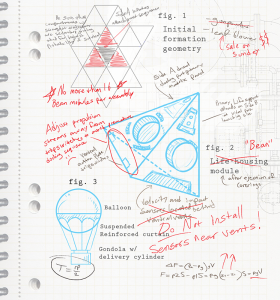An essay by Prof M. A. De Bruin, as provided by Leenna Naidoo
Art by Leigh Legler
I’ve often been told that it is impossible for a private concern, much less a private individual, to set up a safe, secure, and self-sustaining enterprise on the Red Planet. Some have even taken my so-called obsession with Mars, and indeed, settling there, as a sign of mental illness. For this, I must thank those individuals who had me consigned to the Institute for three years, for it was there that I was forced to relax my mind, allowed to experiment with both sound and unsound ideas, and eventually to realise how exceedingly simple it would be to achieve my dream: my own self-sustaining legacy for the future of Mars!
Let me address the first concern of most scholars and engineers about setting up a base on Mars, or even the Moon: the cost of escaping Earth’s atmosphere.
It takes all that fuel (rocket fuel) to propel anything into our atmosphere and to achieve escape velocity. All one hears is: We must expend x amount of exorbitantly expensive fuel in order to create x amount of thrust for x amount of mass to reach escape velocity and then its ultimate destination.
While this was the way in the past, it is not the way of the future, or mine anyway. My calculations and experiments have shown me the remarkably simple, and massively cost-saving, way of conducting all my equipment and supplies into space and onto Mars utilising a simple and old-fashioned method–balloons! These balloons are, naturally, augmented by a few of my new and old inventions.
My calculations showed that the proper use of a fleet of helium balloons will elevate x amount of mass to a height of over 20,000 feet and thus reduce the amount of fuel used by at least 20% as compared to conventional methods!
At this height, my method calls for some ingenuity, if I say so myself, in order to propel my load into space and beyond. Here is where meteorology comes into play!
As the balloon mass glides across the skies, prior careful preparations will ensure that the balloons are near the upward draft of a large supercell storm! This upward draft will draw the balloons swiftly and effortlessly higher into the troposphere whilst simultaneously charging my patented plasma batteries, which are used for navigation and emergency power once out of Earth’s atmosphere. At the same time, of course, the higher pressures within the weather system will be working on the second stage propulsion device–one which is filled with compressed gunpowder. At the optimum pressure, a tiny lightning rod will be extended by each load cylinder attached to individual balloons. Nature will oblige in igniting the gunpowder, gravity will be stunned and escape velocity of the payload will be achieved. Nothing could be simpler!
To read the rest of this story, check out the Mad Scientist Journal: Winter 2016 collection.
Prof M. A. De Bruin graduated in Physics at the University of Eindhoven. He completed his MSc at the University of Los Angeles. Returning to Eindhoven, he pursued a Post Doctorate in Applied Physics. He joined the Mars 2020 team in 2018, replacing Lisa Dereks who disappeared abruptly. In August 2019 De Druin suffered a nervous breakdown after a disastrous accident. Three years later, De Druin left the Happy Days Sanatorium to serve on the boards of two mining companies, Ironcore Ltd and Perseus & Pegasus Corp. In his spare time, he pursues his research and reads Terry Pratchett.
Leenna almost failed Physics at high school, passed first year Electronics for Video Technology easily, and has hankered to study physics further ever since. After quitting ESL Teaching in 2014, she has concentrated on writing women’s fiction and sci-fi/fantasy, including Situation No Win, How Not To Meet The Man of Your Dreams, and Here Be Monsters (set mostly on Mars). She is currently working on her novel, Incident At Wolfe Creek, which is not set on Mars, but on parallel worlds because her favorite theory has strings attached. Her blog is www.leennanaidoo.wordpress.com.
Leigh’s professional title is “illustrator,” but that’s just a nice word for “monster-maker,” in this case. More information about them can be found at http://leighlegler.carbonmade.com/.
“On Conveying Private Material and Persons in the Solar System” is © 2015 Leenna Naidoo.
Art accompanying piece is © 2015 Leigh Legler.

